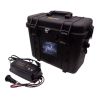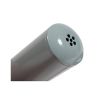Proactive Poseidon 12V Plastic Pumps
Features
- Designed for 2" schedule 40 and 80+ diameter wells.
- Easy to install and operate by connecting to 12V battery
- 400 hour motor life with user-replaceable module
- Free ground shipping
- Expedited repair and warranty service
- Lifetime technical support
- More
Overview
The Proactive Poseidon is engineered for pump tests and groundwater remediation. The Poseidon series pump line will fit into Schedule 40 or 80 2" diameter wells. The models available are: Poseidon 60 (pumps 60 feet depth to water) and Poseidon 80 (pumps 80 feet depth to water).
Easy Installation
The Poseidon pumps are easy to install and operate. Simply attach 3/8" ID polyethylene tubing to the barb tip using a hose clamp and attach suspension rope to the eye hook provided on top of the pump. Then, lower the pump to the desired water depth and energize the pump with a deep cycle marine battery and/or a small solar system.
Long Life Expectancy
The approximate life expectancy of the Poseidon motor module is 400 hours, depending on how often it is used. The patented replaceable motor module can be changed out within 60 seconds, eliminating downtime or expensive service calls. Just twist in the new motor module and start pumping again. Once the new motor module is installed, the pump is essentially new and will have a life span identical to a new pump. The Poseidon pump ships with one motor module installed on the pump. Additional motor modules can be purchased as needed.
- Power Consumption: 150 Watts (max)
- Volt Recommendation: 12-15V at source
- Maximum Amp Output: 10 Amps
- Measurements: 7.5" length x 1.82" diameter
- Required Tubing: 3/8" ID tubing
- (1) 12V Poseidon pump
- (1) Motor module
- (1) Set of 12V battery clamps
In The News
Three Decades of Research at Acton Lake
A multi-disciplinary team at Miami University, Ohio, has been studying the environmental change at Acton Lake for over three decades. Using three different NexSens buoys over this time, the team has an incredible archive of data that is helping build a picture of Acton’s past, present, and future. Until recently, a NexSens CB-50 buoy was used alongside other environmental monitoring at Acton Lake. In May 2025, the Miami team deployed a new XB-200 buoy , future-proofing their ongoing monitoring using real-time buoy systems. Acton Lake, a small hypereutrophic reservoir in southwest Ohio, covers 2.4km² and has a maximum depth of about 8m. The dam was built in 1956, and the lake has a large agricultural watershed.
Read MoreSource Water Monitoring in Albany, New York: Tracing Water Quality throughout Tributaries
Thousands of US cities pull their drinking water from natural source waters like reservoirs, rivers, and streams, making overall watershed health a key consideration for water providers. In Albany, New York, the Albany Department of Water and Water Supply delivers drinking water to over 100,000 residents as well as monitors and manages the larger drinking water supply watershed. Hannah Doherty, Environmental Specialist at the Albany Department of Water and Water Supply , spends her days working with a small team to monitor the drinking supply and the connected water bodies. Doherty explains, “We’re the first to encounter the water that ends up being the drinking water.
Read MoreWildfire Prevention in the Sierra Nevada Region with the Yuba Watershed Institute
Though recent wildfires have sparked new conversations about wildfire management and response, groups like the Yuba Watershed Institute have been monitoring the forests and water resources of the Sierra Nevada region for decades, managing approximately 5,000 acres of land with the Bureau of Land Management (BLM) and about 7,000 acres in private land partnerships. The goal of the Institute is to work with local communities and land agencies to improve watershed and forestry management through informed practices and public outreach. The goals of the Yuba Watershed Institute are three-fold: Improve the ability of fire suppression agencies like the California Department of Forestry and Fire Protection ( CAL FIRE ) and the US Forest Service.
Read More














